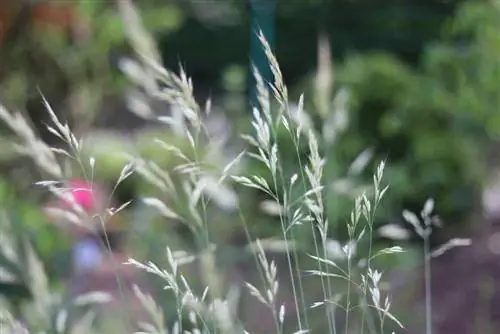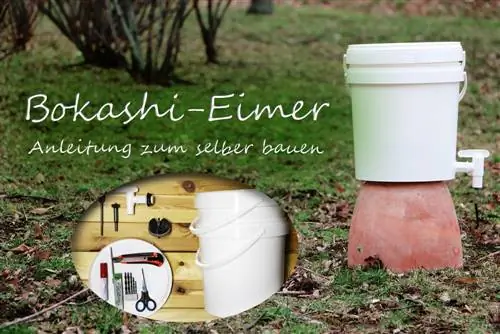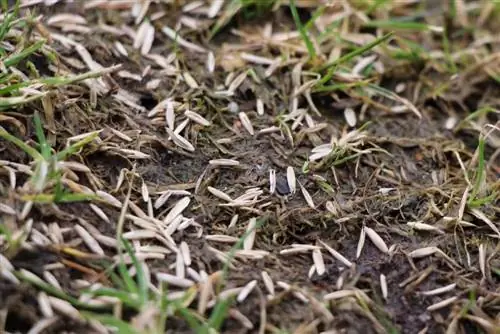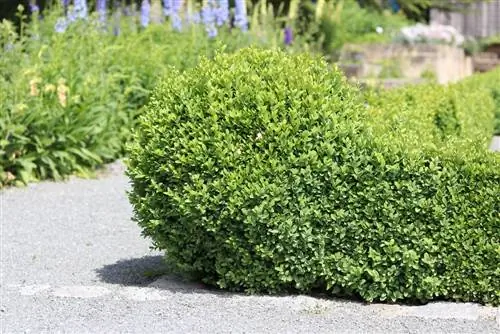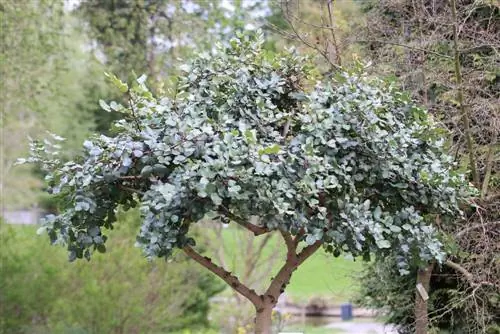- Author admin [email protected].
- Public 2023-12-17 03:39.
- Last modified 2025-01-24 12:45.
You don't always have to expect spectacular flowers from a garden plant. The ornamental grass 'Karl Foerster' scores with its delicate growth. The plant growing as a clump reaches a considerable height. It sits unmistakably in the bed, giving it a clear structure. In winter, its decorative dry stalks protect the garden from a dreary existence. All of this is worth the best care.
Origin
Nature has created many ornamental grasses over time. A wide variety of wild species grow splendidly and without any human intervention. However, the riding grass 'Karl Foerster', from the sweet grass family, is a hybrid of Calamagrostis epigejos, a widely spreading land riding grass, and Calamagrostis arundinacea, a clumpy growing forest riding grass. The hybrid was initially called 'Stricta'. It was later renamed 'Karl Foerster' in honor of the breeder. The botanical name is Calamagrostis x acutiflora. Moor riding grass and garden sandpipe are other terms that are often used when this ornamental grass is mentioned. 'Karl Foerster' has developed into a popular ornamental grass for gardens and containers.
Growth and appearance
The riding grass 'Karl Foerster' is modestly content with the space allocated to it as it grows. It does not grow uncontrolled like other grasses. This property is valued by gardeners. Keeping an overgrown plant under control is complex and time-consuming work.
- forms dense nest
- Culms grow tightly upright
- reach heights of up to 180 cm
The leaves emerge very early in the year. They are shiny dark green and have a shape typical of ornamental grasses: long, pointed and strap-shaped. The first flowers appear in mid-June.
- loosely pinnate inflorescences
- on straight, high stalks
- about 5 cm long flowers
- purple shimmering coloring
- in autumn they look like ears of corn
- then also colored yellow
Location
The best growth is achieved in full sun locations. However, shade should be avoided completely. Partial shade is tolerated to a certain extent, but can affect its appearance. In such a location it often happens that the otherwise upright flower stalks bend over.
Note:
In addition, the stalks are so stable that they do not need to be tied.
Floor
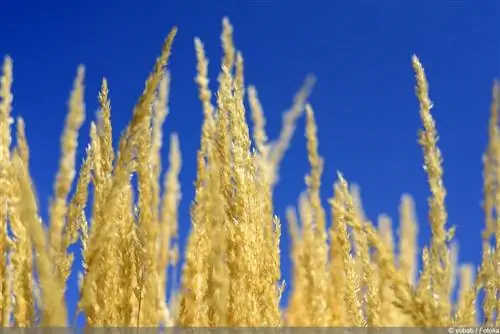
This moor riding grass is adaptable and thrives on a variety of soils. Even moderately dry soils cannot stop its urge to grow. However, it has certain preferences and deserves to have these met if possible:
- fresh soil
- humous and nutrient-rich
- loamy-sandy
- well drained
Tip:
The riding grass benefits from a layer of mulch around the root ball. This prevents weeds and stores heat.
Plants
The ornamental grass 'Karl Foerster' is usually sold in small pots. The roots are in the ground but still quite cramped. Immediately after purchase, it should be freed from its limited housing and planted in the garden or a larger container. The following should be noted:
- good rooting is important
- so plant in spring
- There is enough time to get used to it before frost
- water well after planting
Tip:
The striking appearance of 'Karl Foerster' requires sufficient space to develop its full effect. Plant neighbors should therefore not move closer than 80 cm.
Good neighbors
The riding grass makes a good impression as a solitary plant, but can also be used as part of a group of plants. In the perennial bed, the riding grass provides a beautiful structure and prefers to accompany the following plants:
- Autumn Star
- Coneflower
- larkspur
The plants near 'Karl Foerster' should above all be able to keep up well with its height growth. Specimens that remain small disappear visually quickly. The juxtaposition of ornamental grass and flowering perennials is popular in garden design. A combination of different ornamental grasses is also attractive, provided the variety selection is successful.
'Karl Foerster' as a privacy screen
The eyrie grows so densely that no one can see it. Added to this is the considerable height, which can easily keep up with an adult. The building material for a privacy screen is ready. When several plants are planted next to each other, a green wall is created in the garden. A few pots placed close to the terrace also create a natural demarcation. And best of all: the blades of grass sprout so early in the year that they have completed their opaque work in time for the start of the outdoor season.
Pouring
‘Karl Foerster’ likes fresh earth. This also includes a certain amount of moisture.
- Main supply comes from rainfall
- water additionally if the top layer has dried
- The thirst for water is higher in hot summers
- provide good water during the growth phase
If there is no time for watering, the ornamental grasses still do not let their stalks hang. They easily tolerate drought for a certain period of time. However, the moisture, which many gardeners are not stingy with, is not beneficial for them. Too much water quickly causes their roots to rot. The damage is irreparable and should therefore be avoided as much as possible.
Fertilize
The ornamental grass outdoors does not require targeted fertilization. It is completely sufficient for it if it can use the nutrient supply from neighboring plants. If you absolutely want to offer him additional growth fuel, then use the following nutrient suppliers:
- Compost
- Horn shavings
- Bark humus
The right time to supply fertilizer is in spring, shortly before budding. A second fertilization follows in May before flowering.
Cutting
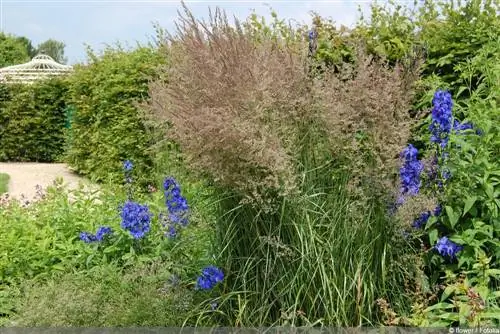
The riding grass 'Karl Foerster' is easy to maintain when it comes to cutting. Its slender, head-high stalks are a welcome sight throughout the summer. They are welcome to stay standing. Especially since they are characterized by their high stability and rarely bend. Even in winter, when the shoots have long since dried up and are looking at us with a yellow color, they do not have to be consecrated. They are a winter decoration, especially when they stand out from a blanket of white snow. However, as new shoots sprout every year, the old shoots eventually need to be cut to make room.
- leave dry stalks standing in winter
- they are a natural protection against cold
- a cut is required later
- in early spring shortly before new growth
- cut off all dry stalks close to the ground
- use sharp secateurs
- Gather the stalks into bunches by hand and cut them off
- Gloves protect against cuts
- Riding grass sprouts quickly
Tip:
The optimal time for cutting must be adjusted. Otherwise, fresh green shoots mix with old, dried stalks. Cutting is then difficult or even impossible.
Propagation
The hybrid Calamagrostis x acutiflora is a sterile plant. It does not produce seeds capable of reproduction. If you want to get another copy of her, you have to buy a young plant commercially or divide your own plant.
- Division will take place in spring
- cut off part of the root ball with a spade
- replant the separated part
Tip:
The riding grass can be divided again in subsequent years as long as it has increased sufficiently in size.
Wintering
'Karl Foerster' can tolerate the icy cold and even personally provides a protective cape. Its stalks, dried in autumn, keep wind and frost away and should therefore not be taken away in winter. They should only be tied together in a bundle so that they keep out moisture like a roof. This prevents mold from forming. Additional man-made protection is welcome:
- lay a thick layer of leaves
- around the root ball
Very cold winter periods without snow bring frost, which can be dangerous for riding grass. As soon as there is a frost-free day, the riding grass should be watered a little.
Diseases and pests
Riding grasses are among the robust plants in the garden. They are usually spared from diseases and pests and do no work in this regard. Leaf rust can only spread when the summer is hot and humid at the same time.
Riding grass as container planting
Ridgegrass is ideal as a pot plant, provided it is given a sufficiently large container. Here too, it sprouts early, grows quickly and forms a dense stalk landscape. A sunny spot on a terrace or balcony is ideal for him. However, cultivating 'Karl Foerster' in a pot requires more intensive care than is the case with garden specimens.
- water more often
- especially when it doesn't get any rain
- Use the watering can every day on hot days
- Avoid waterlogging as this promotes root rot
- create a drainage layer in the pot before planting
- initially the nutrients in the potting soil are sufficient
- fertilize regularly from the second year onwards
- Stop fertilizing from autumn to spring
- cut back in spring
- occasionally repot or divide the nest
- protect from the cold in winter
Overwintering ornamental grass in a bucket
The hardy riding grass is exposed to harsh winter influences in the pot. The cold easily reaches the root from all sides and can lead to frostbite. This can still work well in mild winters, otherwise the ornamental grass urgently needs support in order to reach the coming spring safely and he althily.
- choose a protected location
- Keep pot away from cold ground
- Place the bucket on a wooden block or Styrofoam plate
- Wrap the pot several times with protective fleece
- tie dry stalks together and leave them standing
- they keep out cold wind
- put a layer of leaves on top of the soil layer
- water something on frost-free days
As soon as no severe frosts are expected, the warming covering can be removed again.

